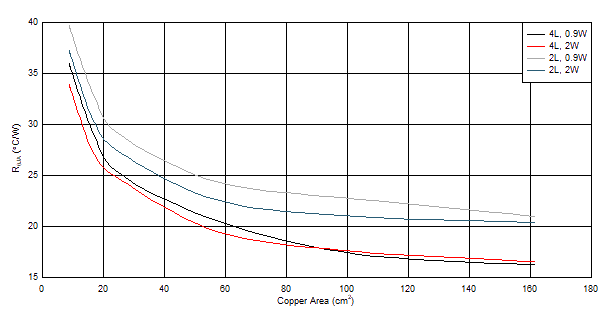JAJSMA0A July 2020 – July 2021 LM63610-Q1
PRODUCTION DATA
- 1 特長
- 2 アプリケーション
- 3 概要
- 4 Revision History
- 5 Device Comparison Table
- 6 Pin Configuration and Functions
- 7 Specifications
- 8 Detailed Description
- 9 Application and Implementation
- 10Power Supply Recommendations
- 11Layout
- 12Device and Documentation Support
- 13Mechanical, Packaging, and Orderable Information
パッケージ・オプション
メカニカル・データ(パッケージ|ピン)
サーマルパッド・メカニカル・データ
発注情報
9.2.2.9 Maximum Ambient Temperature
As with any power conversion device, the LM63610-Q1 dissipates internal power while operating. The effect of this power dissipation is to raise the internal temperature of the converter above ambient. The internal die temperature (TJ) is a function of the ambient temperature, the power loss, and the effective thermal resistance, RθJA of the device, and PCB combination. The maximum internal die temperature for the LM63610-Q1 must be limited to 150°C. This establishes a limit on the maximum device power dissipation and, therefore, the load current. Equation 12 shows the relationships between the important parameters. It is easy to see that larger ambient temperatures (TA) and larger values of RθJA reduce the maximum available output current. The converter efficiency can be estimated by using the curves provided in this data sheet. Note that these curves include the power loss in the inductor. If the desired operating conditions cannot be found in one of the curves, then interpolation can be used to estimate the efficiency. Alternatively, the EVM can be adjusted to match the desired application requirements and the efficiency can be measured directly. The correct value of RθJA is more difficult to estimate. As stated in the Semiconductor and IC Package Thermal Metrics Application Report, the value of RθJA given in the Thermal Information table is not valid for design purposes and must not be used to estimate the thermal performance of the application. The values reported in that table were measured under a specific set of conditions that are rarely obtained in an actual application. The data given for RθJC(bott) and ΨJT can be useful when determining thermal performance. See Semiconductor and IC Package Thermal Metrics Application Report for more information and the resources given at the end of this section.

where
- η = efficiency
The effective RθJA is a critical parameter and depends on many factors such as the following:
- Power dissipation
- Air temperature/flow
- PCB area
- Copper heat-sink area
- Number of thermal vias under the package
- Adjacent component placement
The HTSSOP uses a die attach paddle, or "thermal pad" (DAP) to provide a place to solder down to the PCB heat-sinking copper. This provides a good heat conduction path from the regulator junction to the heat sink and must be properly soldered to the PCB heat sink copper. A typical example of RθJA versus copper board area can be found in Figure 9-4. The copper area given in the graph is for each layer. The top and bottom layers are 2 oz. copper each, while the inner layers are 1 oz. Figure 9-4 shows a typical curve of maximum output current versus ambient temperature. This data was taken with a device and PCB combination, giving an RθJA of about 30°C/W. Remember that the data given in these graphs are for illustration purposes only, and the actual performance in any given application depends on all of the previously mentioned factors.
 Figure 9-4 Typical RθJA versus Copper Area for the HTSSOP Package
Figure 9-4 Typical RθJA versus Copper Area for the HTSSOP PackageThe following resources can be used as a guide to optimal thermal PCB design and estimating RθJA for a given application environment:
- AN-2020 Thermal Design By Insight, Not Hindsight Application Report
- A Guide to Board Layout for Best Thermal Resistance for Exposed Pad Packages Application Report
- Semiconductor and IC Package Thermal Metrics Application Report
- Thermal Design Made Simple with LM43603 and LM43602 Application Report
- Using New Thermal Metrics Application Report